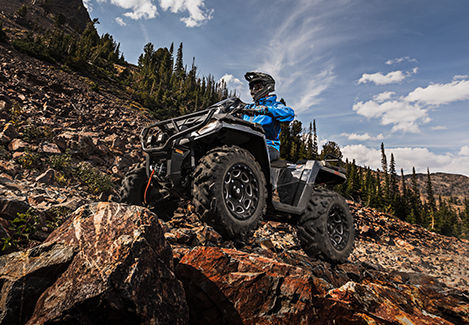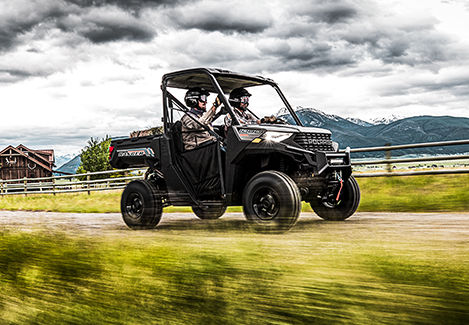
The Best Safety Tips for ORV Drivers
Having fun on off-road trails or getting a demanding job done are high priorities when using an ATV or UTV, but safety should always be the highest priority. Much of the potential danger of riding can be mitigated by undertaking proper UTV/ATV safety training, making sure your off-road vehicle (ORV) is in good working order, and taking the appropriate safety precautions. Whether you've got a new four-wheeler or a side-by-side (SxS), let's review some fundamentals to operating it safely and responsibly.
Cómo estar seguro antes del primer paseo
A great place to start for effective learning on how to operate and ride an ATV or a SxS is a reputable training course. Many of which combine online and/or classroom instruction with supervised riding. The RiderCourse offered by the ATV Safety Institute is an example. Even beyond that kind of supervised teaching, there’s much you can do to make sure you’re ready to safely take to the trails being safely prepared.
¿Qué tamaño de ATV o UTV Side-by-Side es adecuado para usted?
It’s essential to choose the right size machine for a particular rider. This information can be found in the vehicle’s owner’s manual. When it comes to ATVs, make sure you or other riders can effectively and safely control the vehicle.
For youth riders, start by following the age-group recommendation for an ATV of a given size and keep close tabs on your child as he or she learns the ropes of the vehicle. Look for signs that it may be too much for them to handle, regardless of whether they’re considered the appropriate age.
Most UTVs are adult vehicles, meaning the minimum age for operation is 16, with operators having a valid driver’s license. For passengers, they should be tall enough to keep their backs flat against the seat back, their feet flat on the floor and their hands on the hand holds.
For youth UTVs, operators and riders alike should be at least 10 years old. These vehicles also have height requirements that the owner’s manual outline for each vehicle. Lastly, as a parent, you know best your child’s maturity level – this must also be considered when determining if your child is ready to take to the off road.
Equipo de protección todoterreno
Both ATV and UTV riders of all ages must wear helmets, which is in many areas even required by law. Even if you’re belted in within the cab of an enclosed side-by-side, a crash, collision, or rollover can still result in a head injury—especially if riders aren’t wearing helmets.
We’ve prepared a guide specifically on choosing the right ORV helmet, and we urge you to check it out. To summarize, make sure you select a helmet that fits your head properly, that meets or exceeds U.S. Department of Transportation (DOT) and/or SNELL safety standards, and that hasn’t been dropped or involved in a prior accident. Full-face helmets, such as Motocross style, are recommended for off-roaders.
A face shield or goggles provide required and essential additional eye protection to be integrated with a riding helmet. After all, your head may be protected by a helmet, but if dust or sand gets in your eyes, your vision is dangerously impaired—even if just for a moment.
Both ATV and UTV riders must wear sturdy, over-the-ankle boots for the best grip on the footrests and the best protection against rocks, brush, and debris, as well as the heat of your machine.
Long pants and a long-sleeved shirt are also required when off-roading. Riding pants and a riding jacket or vest provide further protection, offering insulation and protective padding while enhancing comfort; you can also add elbow, shoulder, and knee pads and/or chest protectors to your outfit for bolstered security. Rainwear or heavier-duty shells may be advisable depending on the weather conditions and season you’re riding in.
Riding gloves - also required - improve your grip and protect your hands against chafing, debris, and the strain of your ORV’s vibration.
Inspección del vehículo todoterreno
Whether it’s your first or your fiftieth ride on an ATV or UTV, always thoroughly assess your vehicle before setting out. Pre-ride inspections can reveal malfunctioning or damaged vehicle components, low fluids, and other issues that could get in the way of your day on the trails.
Check your tire pressure and visually inspect tires for wear, punctures, and other issues; ensure wheel and axle nuts are tight, and try to rock tires to pinpoint loose fasteners or worn bearings. Make sure all lights, switches, and gauges are operating correctly. Check fuel, lubrication, and coolant levels, and look for any signs of leakage. Check throttle adjustment (if applicable), shifter, and brakes.
Give other fundamental parts of the system—from the drivetrain and suspension to cargo racks and boxes—a once-over to identify any potential loose parts, breakage, or other problems.
The owner’s manual for your ATV/UTV contains a pre-ride inspection checklist to use each time you ride so you’re always covered. This is one of those simple steps that can pay off big time in terms of warding against preventable vehicle breakdowns and injuries.
Comprender los controles y las partes
Asegúrese de entender el funcionamiento básico de su ATV o UTV Side-by-Side antes de arrancarlo. No asuma que sabe cómo operar un modelo desconocido solo porque podría tener experiencia con otro vehículo. Hay un poco de variación inherente en cómo se diseñan los vehículos todoterreno y además, cada vehículo se maneja de manera diferente y tiene su propia sensación con la que tendrá que familiarizarse.
Estudie el manual del propietario y tómese el tiempo para practicar en un área segura, nivelada y accesible para que se sienta cómodo con la máquina antes de llevarla a un paseo de larga duración. Cuando se trata de operadores más jóvenes, es útil dejarlos explorar la máquina bajo su estrecha supervisión.


Técnicas de conducción para principiantes del manejo todoterreno
Además de los consejos mencionados anteriormente, asegúrese de invertir las horas de práctica requeridas. No apresure las cosas. Cree una base de técnicas y resolución de problemas, y habrá sentado las bases para la conducción avanzada a su debido tiempo.
Aprender a manejar de forma segura
Como se mencionó anteriormente, practique primero en un área nivelada, bien graduada y libre de obstáculos donde pueda familiarizarse con la sensación y la respuesta de sus ruedas en un entorno seguro.
Tanto en el campo de práctica como en sus primeros senderos, opte por una conducción más lenta y estable. Para empezar, debe sentirse cómodo con su ATV o UTV en senderos manejables de nivel principiante. Por ejemplo, si es nuevo en el tema de vehículos todoterreno, tome tiempo para dominar el arte de usar el peso corporal al virar.
Hay consejos específicos para principiantes, como no cerrar los codos al maniobrar un vehículo de cuatro ruedas y no abuse del acelerador o pedal. Llegará a la etapa de habilidades de manejo más avanzadas, pero concéntrese primero en los fundamentos y tome en serio la seguridad. Ser imprudente puede traducirse rápidamente en lesiones a usted o a otra persona; las posibilidades de un incidente de este tipo se reducen si aborda el aprendizaje del manejo de un vehículo todoterreno en particular a través de un proceso detenido y paso a paso.
Si planea el manejo todoterreno en campos rurales o de otro modo remotos, recuerde traer fluidos (no combustible u otros líquidos inflamables), bujías de repuesto y artículos esenciales para vehículos. También se recomiendan suministros básicos de emergencia, como alimentos y agua adicionales, mantas, materiales para crear una fogata, herramientas de comunicación/señalización de respaldo y un kit de primeros auxilios.
Comprender en qué tipo de terreno debe manejar
By its very nature, off-roading involves understanding different kinds of terrain. Learn which ORV, tires and other modifications are required to tackle different terrain types. Keep in mind that using the wrong setup for the riding terrain can hinder your vehicle’s performance.
Also, technique-wise, different landscapes call for different kinds of riding. You’ll want to achieve base-level off-roading competence before tackling difficult-rated off-road trails or specialized terrain such as mud pits or dunes.


Cómo sentarse correctamente en un ATV o en un UTV
La posición adecuada del asiento es esencial para un manejo eficaz de un vehículo de cuatro ruedas. Con experiencia, aprenderá cuándo es mejor “pararse” mientras opera un ATV a fin de emplear más eficazmente su masa corporal para estabilizar el ATV y dar vueltas. Evite bloquear los codos en un ATV para evitar el estrés doloroso y potencialmente dañino en las articulaciones y las manos.
Asegúrese de sentarse cómodamente en el ATV o Side by Side mientras pueda alcanzar todos los controles sin hacer un esfuerzo. Los asientos de UTV deben ajustarse para permitir una distancia cómoda a los pedales y una posición de conducción relajada con los codos doblados. El hacerlo permitirá una experiencia más cómoda, evitando la tensión de los hombros que podría resultar de un largo día de manejo tenso. Los pasajeros también deben ser capaces de sujetar cómodamente las barras de sujeción en una posición de conducción relajada sin bloquear los codos.


Cosas que debe evitar durante el manejo todoterreno
Muchos contratiempos en el manejo todoterreno se deben a la imprudencia, a sobreestimar sus habilidades y/o al desconocimiento de su entorno, de las reglas del manejo todoterreno y a lo que hacen otros en su grupo de paseo. Aquí hay dos errores especialmente comunes que comprometen la seguridad del vehículo todoterreno y lo ponen a usted y a otros en riesgo.
Conducir demasiado rápido
Resistir la necesidad de conducir a velocidades excesivas a lo largo de cada paseo es uno de los componentes más importantes de la seguridad del Side-by-Side/ATV. A altas velocidades, tiene menos control, y los obstáculos aparecen en el camino con mucho menos advertencia. Las vueltas son más difíciles de ejecutar, los hoyos y los baches dan un golpe mucho más intenso y el ímpetu lo puede vencer. Familiarícese con la máquina a baja velocidad para entender cómo reacciona en varias condiciones. Evite conducir más allá de sus habilidades; conduzca a velocidades cómodas para permitirle a usted y a su grupo disfrutar de la experiencia de manejo.
No conocer las leyes y reglamentaciones
Siempre familiarícese con las reglas y reglamentaciones de vehículos todoterreno para una ubicación determinada. Estas leyes no solo están destinadas a protegerle a usted, a otros usuarios y al medio ambiente: También ayudan a proteger que la capacidad de manejar vehículos todoterreno pueda continuar en un lugar determinado. Ignorar las reglamentaciones puede hacer que usted o alguien más se lastime, dar lugar a una multa desagradable y potencialmente impedir oportunidades de manejo para otros en esa área.
Nunca pierda de vista la seguridad del Side-by-Side/ATV
Ya sea que sea o no que participe en el manejo todoterreno, es esencial reconocer el riesgo inherente cada vez que se suba a un vehículo todoterreno. Su seguridad, y la de los que le rodean, es primordial. Aprenda lo básico, manténgase consciente de la situación de manejo y las condiciones en todo momento y, por supuesto, ¡diviértase!





